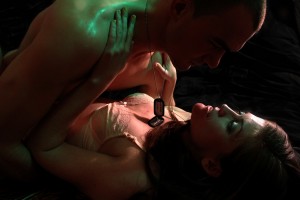Green Eyes by Tennessee Williams, Company One in collaboration with Chris Keegan and The Kindness, The Ames Hotel, 1/18/12-2/26/12, http://www.companyone.org/Season13/Green_Eyes/info.shtml. Contains nudity.
Reviewed by Anthony Geehan
(Boston, MA) “Welcome to my honeymoon,” the manic looking blond in the short white dress says “I do expect an invitation to yours.” She snaps a picture of the audience on an out of date Polaroid and then has one of its members unzip her dress as she strips down and gets into bed. This is the first part of the voyeuristic experience that is Green Eyes, a lost Tennessee Williams play currently being put on by a Company One and The Kindness at the Ames Hotel in Boston.
Green Eyes tells the morning after story of the newly married Mr. and Mrs. Claude Dunphy (Alan Brincks and Erin Markey), who are spending their honeymoon in New Orleans between Claude’s tours of duty in Vietnam. One night, on New Orleans infamous Bourbon Street, the couple separate after a night of heavy drinking and find themselves the next morning at odds over a series of bruises and bite marks on Mrs. Dunphy’s body. The play chronicles the morning confrontation and delves into Claude’s fear of inadequacy, sexual frustration, and disturbed psyche that stems from the tasks he was ordered to perform in the line of duty.
Green Eyes is a play that is full of everything Tennessee Williams has come to be known for. The Dunphy’s are a young, southern couple whose minds are occupied with thoughts of money, sex, and the future. Mrs. Dunphy is constantly trying to seduce her husband out of his frustration and anger while Claude simply continues to drink him self into a violent sermon about his wife’s supposed infidelities (harking back to William’s famous Cat on a Hot Tin Roof). The character of Mrs. Dunphy also tends to dominate the scenes and conversations, dismissing Claude’s anger and psychosis as childish and weak (reminiscent of Blanche DuBois and Stanley Kowalski in A Street Car Named Desire). While there are several things that give the play away as a William’s play, there are some original features to the plot. Claude’s guilt over his war crimes is a new subject for William’s, with his mental strain taking the physical form of hallucinations of soldiers and sounds such as helicopters and gunfire. Also the fact that Mrs. Dunphy remains without a first name is an ironic point of the script, being that she is arguably the most dominating character in the story.
The main strength of the play lies within the actors and the production rather than the script. The spectacle of watching Brincks and Markey in an actual hotel room, mostly naked and extremely intimate, works to take the audience away from the fact that they are simply watching a play and invokes both the guilt and excitement of voyeurism. This is further strengthened by the fact that Markey’s first action is to acknowledge the audience and be not only accepting of them, but extremely flirtatious with the crowd. The play is made more intriguing by the extremely opposite nature of Brinks and Markey bodies. Both come close to being human archetypes, with Markey being a slim and somewhat short female with blond hair and pronounced facial features while Brinks being an extremely large, muscular man, with a shaved head and cold facial expressions. This has a duel effect of making the intimate scenes more attractive to look at and making the scenes where Brinks becomes physically violent with Markey extremely unnerving.
If there is fault to be found in the play, it would have to be in its brevity. The play itself only runs about 45 minutes, which seems strange for such an unusual and elaborate setting. There are also slight problems with the seating arrangement, where the back two rows have an obscured view of certain areas of the room where some of the play takes place. Despite this, the play is an extremely well preformed piece from one of America’s most celebrated playwrights. It is a rare event for theater goers and is an event that celebrates the fact that theater is not only unique in what is preformed, but also where.

